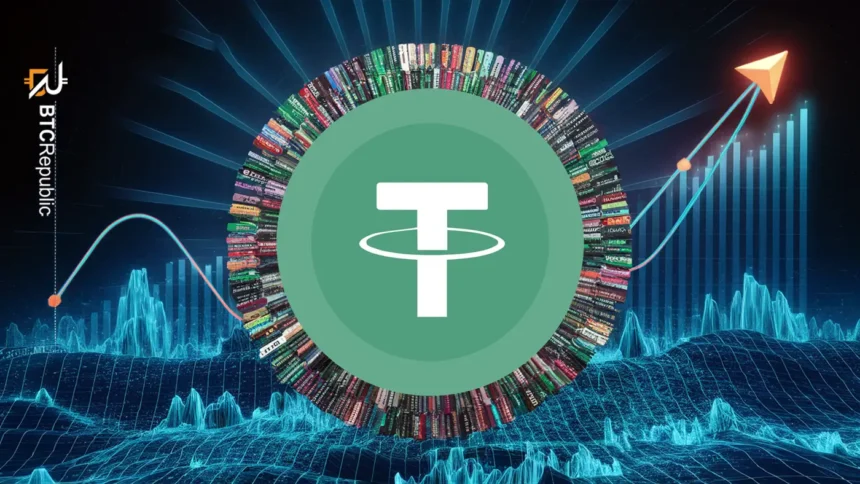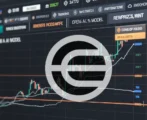Crypto exchanges are platforms where users buy, sell, and hold digital assets like Bitcoin, Tether (USDT), and altcoins. They act as the main gateway between traders and the crypto market.
In August 2024, Tether balances on these exchanges reached a new all-time high (ATH), a move that has caught the attention of traders worldwide. This rise points to growing liquidity and possible price movement ahead. According to our latest Bitcoin Price Analysis 2025, this trend aligns with increased market readiness.
In this article, BTCRepublic breaks down the key numbers and shows what this signal could mean for your next trade.
- Key Takeaways
- Facts & Original Research: On‑Chain Signals That Matter
- What Is Tether and Why It’s Piling Up on Crypto Exchanges
- Tether Treasury mints $1B worth of USDT
- The Logic Behind Tether’s Latest Strategy
- Tether is Facing a Legal Battle
- Other Notable Tether Initiatives
- Are USDT investors waiting on the sidelines?
- Conclusion
- Frequently Asked Questions (FAQs)
Key Takeaways
| Insight | Summary |
| Tether (USDT) balances hit new ATH | Over $16.3B now sits on crypto exchanges, signaling increased market readiness. |
| More USDT equal to More Buying Power | Traders are likely preparing to enter positions, especially in Bitcoin and altcoins. |
| Liquidity shows market may recover | Rising reserves suggest confidence is returning after the 2024 dip. |
| Institutions are active again | Large wallets and whales are moving stablecoins, hinting at possible reentry. |
| Use tools like Glassnode & CryptoQuant | Track Tether flow in real time to spot early trading signals. |
| Don’t rely on USDT alone | Combine stablecoin data with price zones, RSI, and chart levels for smarter trades. |
| Past patterns show repeat behavior | Similar Tether spikes occurred before major rallies like Solana’s 200% jump. |
Facts & Original Research: On‑Chain Signals That Matter
Key Data & Statistics
| Metric | Figure | Why It Matters |
| USDT Exchange Balances (2024) | Exchange-held USDT rose sharply, with a 146% increase to ~$22.7 billion. | Shows traders are moving large capital into exchanges liquidity ready to flow. |
| 7‑Day Moving Average Change | USDT held on exchanges rose by $568 million (7‑day average) highest in a year. | Sustained inflows (not just one‑day spikes) are stronger signals of momentum. |
| USDT vs. Bitcoin Price Correlation (Jan–Jul 2024) | Inflow spikes lined up with Bitcoin rallies. | Suggests Tether movements often precede or accompany price moves. |
| Leverage & Collateral Shifts | Exchange USDT balances rose 32% in a month (late 2024). Futures open interest on BTC‑USDT dropped ~7%. | As USDT rises, leverage risk may fall and positions become less fragile. |
| Tether Treasury’s Role | Tether minted $1 billion “inventory replenish” tokens, some stored until needed. | Demonstrates how the issuer manages liquidity before releasing new supply. |
| Tether & U.S. Treasury Market | In Q1 2025, Tether held ~$98.5 billion in U.S. Treasuries about 1.6% of all outstanding bills. | Highlights how stablecoin behavior links directly to traditional finance. |
What Is Tether and Why It’s Piling Up on Crypto Exchanges
Tether (USDT) is a digital token designed to stay equal in value to the U.S. dollar. Each token represents one dollar, making it a stablecoin often used as a safe place for traders to park funds during volatile market swings.
Traders move USDT to crypto exchanges when they’re ready to buy assets or expect new price movements. When monitoring USDT flows, it’s always smart to protect your crypto holdings properly — for step-by-step guidance, check our Crypto Safety Tips 2025.
A higher amount of Tether on exchanges usually signals stronger liquidity and rising trader interest. It often acts as an entry signal, showing that money is waiting on the sidelines for the next big move
Tether Treasury mints $1B worth of USDT
According to Glassnode data, Tether’s Ethereum network assets have risen by USD 1 billion this month. With this, its USDT balances on crypto exchanges stand at 20.339 billion as of August 13, 2024.
This seems to imply that investors are getting ready to plow their stablecoins into crypto assets as anticipation builds toward the U.S. Fed’s September rates announcement.
Earlier in July, the Financial Times reported that the FED is likely to lower interest rates in its forthcoming decision.
Tether’s Ethereum transaction significantly bolsters its circulating supply, and it’s just one of the strategies the company employs to influence liquidity in the crypto market. Understanding market psychology is key when seeing huge USDT inflows, learn how mindset affects trading in our Crypto Trading Psychology Guide.

The Logic Behind Tether’s Latest Strategy
In the aftermath of Tether’s new policy, Tether CEO Paolo Ardoino made further clarification about the transaction on X.
According to him, the increased minting is meant to serve as an Ethereum Network “inventory replenish” while revealing that the transaction was “authorized but not issued.” In simpler terms, this means that the tokens are stored to cater to future issuance requests and chain swaps.
In finance, replenishment of inventory has to do with placing new stock orders to satisfy demand while simultaneously guarding against overstocking. Hence, Tether’s creation of USDT is meant to ensure enough reserves.
These reserves are held in its treasury till there is a need for them. This strategy helps promote efficient management of liquidity while guarding against immediate release into circulation.
According to data from the company’s Transparency page as of August 14, USD 941.72 million in USDT are presently “authorized but not issued” on Ethereum.
This implies that nearly 60 million USDT from the above-mentioned USD 1 billion mints are already in circulation, an indication of strong demand.
If the Fed decides to lower interest rates as expected by the CME and other analysts, there could be increased optimism in the industry.
Markus Thielen, lead researcher at 10x Research notes that almost USD 2.8 billion was issued by Tether and Circle last week, meaning that institutional investors are injecting new capital into the crypto market.
According to him, a continuation of this trend of issuance, as opposed to just minting, could see BTC make further gains.
Tether is Facing a Legal Battle
Tether’s latest policy is coming at a time when the company says it will commence procedures to defend itself from a “shakedown” litigation instituted against it by Celsius, a crypto lender that is now bankrupt.
Last week, Celsius approached a U.S. Bankruptcy Court located in New York’s Southern District to mandate Tether to give up 57,428.64 BTC or in the alternative, to award the “present value of all Bitcoin,” (about USD 3.3 billion in current rates).
The case revolves around a loan deal between Tether and Celsius that empowered the latter to borrow stablecoins in other to operate some critical areas of its business.
Other Notable Tether Initiatives
Tether is helping efforts at a decentralized ecosystem encompassing day-to-day consumer services. A notable project the company is involved in in this direction is known as Pear Credit. Pear Credit is a transparent accounting mechanism based on peer-to-peer technology.
Tether has also committed its resources to GenAI cloud platforms, a clear indication of its interest in stimulating technological innovation. USDT is the largest stablecoin in the world by market capitalization.
Are USDT investors waiting on the sidelines?
Historically, Tether’s balance on exchanges has increased during both bear and bull markets. In bearish conditions, the rise in USDT reserves often signals that traders convert volatile cryptocurrencies into stablecoins, seeking safety amid market uncertainty. Conversely, during bull markets, USDT accumulation may indicate that traders are stockpiling stablecoins to deploy them for crypto purchases when prices drop.
Recent signs show the potential for a bullish case.
For instance, on Aug. 13, Tether Treasury sent $141.50 million USDT to crypto trading firm Cumberland. The latter forwarded the capital across multiple crypto exchanges, including Binance, Coinbase, and Kraken, according to Lookonchain.
Cumberland has sent $1.08 billion in USDT to crypto exchanges in over a week, suggesting that institutional players might be positioning themselves for potential market volatility ahead of the Fed’s September rate decision.
If the Fed’s decision leans towards a rate cut, as the CME data strongly indicates—it could spark optimism in the market.
“Nearly $2.8 billion was issued by Tether and Circle earlier last week, indicating that some institutional investors are injecting fresh capital into the crypto market,” argues Markus Thielen, head researcher at 10x Research, in his latest report, adding:
Conclusion
USDT reserves on crypto exchanges are rising fast, hitting new highs not seen since the last bull run. This is a signal worth watching, especially if you trade altcoins or monitor liquidity shifts.
But remember, Tether alone doesn’t move the market. Always use it with price charts, support levels, and volume indicators.
Frequently Asked Questions (FAQs)
Does a high Tether balance on crypto exchanges mean Bitcoin will go up?
Not always. A high USDT balance shows liquidity is available, but it doesn’t guarantee a price increase. It’s a signal that traders are ready to act, not that they already have. Always confirm with other indicators.
Why are traders moving stablecoins to exchanges right now?
Traders usually move stablecoins like USDT to exchanges when they’re preparing to buy. It’s a common step before entering positions in Bitcoin, Ethereum, or altcoins, especially after a market dip.
Which crypto exchanges hold the most Tether right now?
As of August 2024, the top USDT holdings are Binance, OKX, and Coinbase. These platforms handle the highest volume, so their inflows matter most when tracking potential price moves
Is it safe to trade based on Tether flow data?
Tether flows are useful signals, but they’re not enough on their own. Combine them with support/resistance zones, volume, and RSI for better timing. Don’t rely on one signal to trade.
Can I track Tether flows from my country?
Yes. Whether you’re in the U.S., Brazil, the U.K., or anywhere else, you can use global tools like Glassnode, CryptoQuant, and DeFiLlama. These platforms work worldwide, offering real-time access to USDT flow data.










